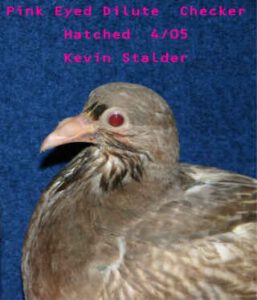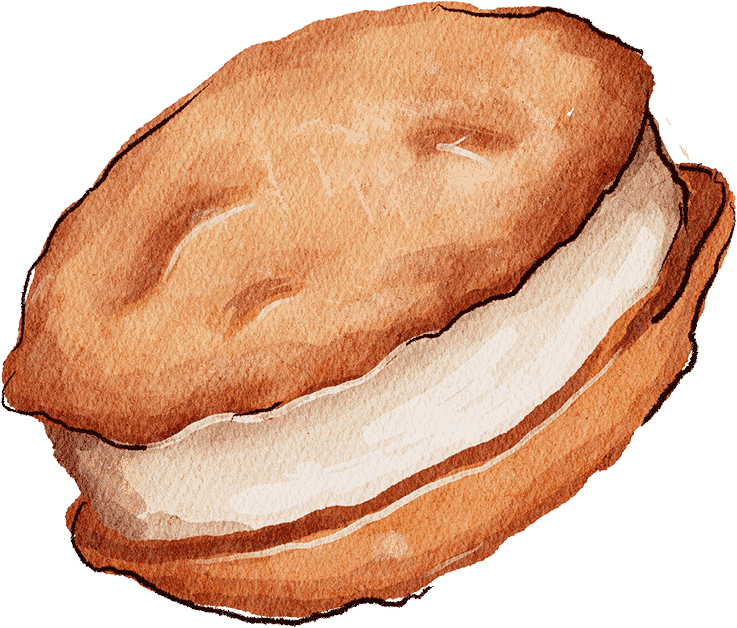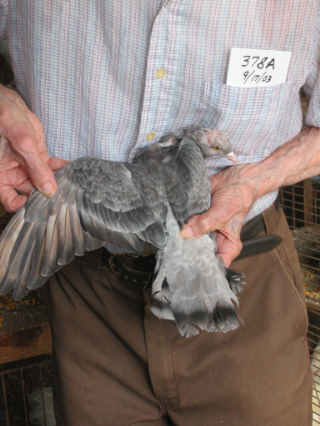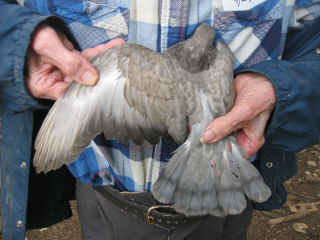Dr. Willard Fisher Hollander – (April 15, 1913-January 5, 2004)
Pigeon Genetics
 Over the past three quarters of a century Dr. Hollander affected nearly everyone in the pigeon industry and “Fancy”. His dedication to everything pigeon is unmatched in history. It is likely that the pigeon you last held in your hand had a genetic character that Dr. Hollander analyzed, worked with, or even named.
Over the past three quarters of a century Dr. Hollander affected nearly everyone in the pigeon industry and “Fancy”. His dedication to everything pigeon is unmatched in history. It is likely that the pigeon you last held in your hand had a genetic character that Dr. Hollander analyzed, worked with, or even named.
In Austin, Texas his interests and experience with pigeons began as is it did for many of us. At age 11 he had a makeshift loft, birds that he captured himself, and tolerant parents. Unlike most of us though, his hobby turned into a career and experiences that remain unmatched.
 Throughout his academic career in Genetics he pioneered new fields of study. His studies included the laboratory fly (Drosophila melanogaster), and mice until the last couple of decades. His studies with mice were important in the wake of World War II and use of the Atomic Bomb. He studied the effects of X-rays on chromosomes and inheritance of those effects. Especially with his continued pigeon research, this broad background allowed him to develop methodologies including improved genetic diagramming, symbols, and using a “wild type” or standard type reference that makes generalizing and analyzing classical genetics more clear and accurate than anyone before him.
Throughout his academic career in Genetics he pioneered new fields of study. His studies included the laboratory fly (Drosophila melanogaster), and mice until the last couple of decades. His studies with mice were important in the wake of World War II and use of the Atomic Bomb. He studied the effects of X-rays on chromosomes and inheritance of those effects. Especially with his continued pigeon research, this broad background allowed him to develop methodologies including improved genetic diagramming, symbols, and using a “wild type” or standard type reference that makes generalizing and analyzing classical genetics more clear and accurate than anyone before him.
 His love for pigeons, nevertheless, was the focus of his life’s work. In the early days, he worked closely with Wendell Levi at the Palmetto Pigeon Plant and was at the center of the squabing industry where there were thousands of birds, and was able to make important contacts around the world. At this time he contributed significantly to the production of what is considered the pigeon breeder’s bible, The Pigeon. Hollander wrote and illustrated the entire chapter on Genetics and in Levi’s own words, “the project would have never been completed without him”.
His love for pigeons, nevertheless, was the focus of his life’s work. In the early days, he worked closely with Wendell Levi at the Palmetto Pigeon Plant and was at the center of the squabing industry where there were thousands of birds, and was able to make important contacts around the world. At this time he contributed significantly to the production of what is considered the pigeon breeder’s bible, The Pigeon. Hollander wrote and illustrated the entire chapter on Genetics and in Levi’s own words, “the project would have never been completed without him”.
 As time went on Dr. Hollander moved his family three times and always took his birds with them. He finally set roots in Ames, Iowa, where he taught and conducted research at Iowa State University for many years. Even after his retirement his research at home continued. His interests in oddities, linkages, and new mutants was always at the forefront of his life. During this time his projects included work with chickens, ringneck doves, muscovy ducks, and of course his pigeons. It was here that he found the Sideburns mutant in his own flock. Produced by an elderly and slightly under the weather pair, this mutant causes the feathers along the beak to grow forwards instead of the usual backwards. Sometimes there is a tuft present above the beak as well as ear whirls of feathers. The mutant is co-dominant, and the homozygote has a head tremor. Besides this variable expressivity, sideburns was possibly the first example in pigeons that also exhibited reduced penetrance in that in a few birds, the gene could be present and not show an effect until passed on to the next generation. Azuro, Gauzy and other mutants that occurred in his research flock continue to be analyzed.
As time went on Dr. Hollander moved his family three times and always took his birds with them. He finally set roots in Ames, Iowa, where he taught and conducted research at Iowa State University for many years. Even after his retirement his research at home continued. His interests in oddities, linkages, and new mutants was always at the forefront of his life. During this time his projects included work with chickens, ringneck doves, muscovy ducks, and of course his pigeons. It was here that he found the Sideburns mutant in his own flock. Produced by an elderly and slightly under the weather pair, this mutant causes the feathers along the beak to grow forwards instead of the usual backwards. Sometimes there is a tuft present above the beak as well as ear whirls of feathers. The mutant is co-dominant, and the homozygote has a head tremor. Besides this variable expressivity, sideburns was possibly the first example in pigeons that also exhibited reduced penetrance in that in a few birds, the gene could be present and not show an effect until passed on to the next generation. Azuro, Gauzy and other mutants that occurred in his research flock continue to be analyzed.
 Along with his research at home, Hollander felt it would be important to seek out greater variation among pigeons near the probable center of origin of domestic breeds. He set off on two such expeditions. one to Turkey with long time friend Bob Pettit, and a second to Egypt with his son Andy. These trips helped to build his encyclopedic knowledge of historical pigeon breeds and how they were kept.
Along with his research at home, Hollander felt it would be important to seek out greater variation among pigeons near the probable center of origin of domestic breeds. He set off on two such expeditions. one to Turkey with long time friend Bob Pettit, and a second to Egypt with his son Andy. These trips helped to build his encyclopedic knowledge of historical pigeon breeds and how they were kept.
 Over the course of his life, his published works have been presented in every forum that a pigeon fancier may look for information. He published several books, countless articles and started the Pigeon Genetics News Letter as first editor. It later became with other editors, the Pigeon Genetics News, Views & Comments newsletter for many years, and he continued to contribute to it right up to the end. It literally takes about an hour just to (even silently) read the list of all of the articles that he has written.
Over the course of his life, his published works have been presented in every forum that a pigeon fancier may look for information. He published several books, countless articles and started the Pigeon Genetics News Letter as first editor. It later became with other editors, the Pigeon Genetics News, Views & Comments newsletter for many years, and he continued to contribute to it right up to the end. It literally takes about an hour just to (even silently) read the list of all of the articles that he has written.
 Going to a Pigeon Show with him was like trying to get a Rock Star through a crowd of screaming fans, without the screaming. From the time we arrived, until he was too tired to go on, he was dragged willingly from bird to bird looking at new developments in a breed that he likely aided or advised on. Maybe it was a mosaic that he was drawn to, (and he explained that phenomenon in two scientific papers); or some color or combination no one else could diagnose. There was always a question for him. Frequently his answers were in the form of questions and his teaching methods helped many learn about genetics, often without them knowing it. He always helped anyone that asked, no matter what their level of experience, and would often diagram matings on scratch paper that he always carried just for that purpose.
Going to a Pigeon Show with him was like trying to get a Rock Star through a crowd of screaming fans, without the screaming. From the time we arrived, until he was too tired to go on, he was dragged willingly from bird to bird looking at new developments in a breed that he likely aided or advised on. Maybe it was a mosaic that he was drawn to, (and he explained that phenomenon in two scientific papers); or some color or combination no one else could diagnose. There was always a question for him. Frequently his answers were in the form of questions and his teaching methods helped many learn about genetics, often without them knowing it. He always helped anyone that asked, no matter what their level of experience, and would often diagram matings on scratch paper that he always carried just for that purpose.
 For those who may not have attended the same shows, there was his correspondence, which was voluminous. One recipient saved and counted 1051 letters over a 33 year period. That is just one example of a staggering collection of letters that were passed back and forth over the years. To this date, ALL of the letters he received and copies of his responses are maintained in his archives.
For those who may not have attended the same shows, there was his correspondence, which was voluminous. One recipient saved and counted 1051 letters over a 33 year period. That is just one example of a staggering collection of letters that were passed back and forth over the years. To this date, ALL of the letters he received and copies of his responses are maintained in his archives.
Both at shows and by correspondence, Dr. Hollander gave away many pigeons. He always donated them to breeders/fanciers. Nearly all were willing to pay something, but he never charged anything.
 Now he is gone. But like that same Rock Star, his memory and work will continue forever. The tools that he left for us, and the work he started, will be used for years to come. As we look at new mutations and “oddities” we will be better able to understand them because of Dr. Willard F. Hollander.
Now he is gone. But like that same Rock Star, his memory and work will continue forever. The tools that he left for us, and the work he started, will be used for years to come. As we look at new mutations and “oddities” we will be better able to understand them because of Dr. Willard F. Hollander.
 Recently a Web site dedicated to Dr. Hollander was started by Dave Rinehart of Ohio. The site, www.rarepigeongenes.com , lists the rare mutants that Dr. Hollander worked closely with and that may need continued attention. Sources and descriptions of the genes are listed along with pictures of the phenotypes they produce.
Recently a Web site dedicated to Dr. Hollander was started by Dave Rinehart of Ohio. The site, www.rarepigeongenes.com , lists the rare mutants that Dr. Hollander worked closely with and that may need continued attention. Sources and descriptions of the genes are listed along with pictures of the phenotypes they produce.
Dr. Hollander had an impact on all of us, and whether he was a reference in a book, a source of advice through correspondence, a colleague, or a good friend with a great sense of humor, we will all miss him.
As he used to say about Charles Darwin, I will say about him…” I don’t always remember exactly what Dr. Hollander said, but I am sure he was right”.
-Kevin Stalder and Dr. Wilmer Miller

Get In Touch!

Contact Me
Kevin Stalder
Phone
(235)-462-4634
Address













